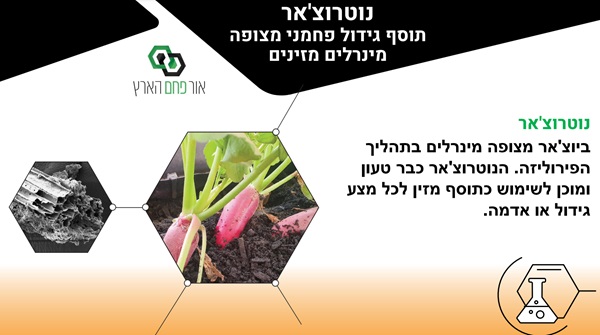Biochar a natural absorption material – Earth Biochar
Our biochar is made from clean pruning of agricultural wood, blended and charged with our rich compost. Using high pyrolysis temperatures, we produce a highly porous, sponge-like biochar which maintain good air-water balance in the plants root zone. Our biochar-compost culture media creates a healthy ecosystem which reduces pathogen prosperity from a single pest and disease outbreaks. The physical and chemical properties of our biochar-compost culture media provide consistent water-nutrients reservoir which guard your plants during stress events.
(עברית)
מוצרי ביו פחם לגינון וחקלאות
נוטרוצ’אר
הנוטרוצ’אר מיוצר על בסיס ביוצ’אר שבתהליך פירוליזה מצופה במינרלים. הנוטרוצ’אר טעון ומוכן לשימוש כתוסף מזין לכל מצע גידול או אדמה.

Earth Biochar is a young subsidiary company of Compost Or, specialized in treating various organic materials using pyrolysis to develop a variety of biochar products.
We develop two basic biochar products lines: Our first product is an agricultural soilless growing media and the second product line are absorptive materials for neutralizing contaminations.
Nowadays biochar is considered a new and interesting material for agriculture, gardening and other uses but it is worth knowing that it has centuries-old origins. In fact, it was first discovered during geological studies in the Amazon forests in Brazil (and later in other regions of the world and even in the Mediterranean).
The researchers examined the mystery of a defined fertile areas for local agriculture in the poor rainforest soils.
These fertile areas were called “Terra Preta de Indio”, the black soil of the Indians. It turned out that this soil has a thick layer (approx. 50 cm) of charcoal blended with other composted organic materials. This rich black layer was created for centuries by the indigenous Amazonian tribes using a traditional method of burning and charring piles of organic waste (food scraps, plants, Human faeces, etc.). The researchers found that the char is a key component of the Amazonian soil fertility.
Since it was born, the new term – “Biochar” –has greatly attracted researchers worldwide and its research led to a deep understanding of the mechanisms of biochar activity in the soil.
What is the difference between biochar and BBQ charcoal?
Basically, there are two major differences.
It is also essential to understand that BBQ charcoal produced in traditional charcoal kilns is both an environmental pollutant and leaves toxic substances in the charcoal that may harm life in the soil.
Biochar enhance microbial activity in the soil
Since biochar absorbs nutrients and water, it provides optimal environment for microorganism’s growth in the soil. Hence, a large variety of microorganisms develops and populates the biochar pores like a huge residential building. We now know that increasing the diversity of the microbial population in the soil creates a healthy ecosystem and reduces disease outbreaks in the soil from a single pest. Another advantage is the increased availability of plant nutrients from microbial activity of the biochar.